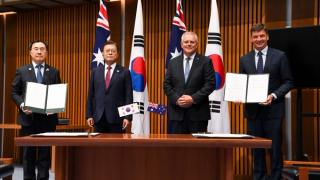The United States and China have oversized impacts on the fortunes and policies of Australia for obvious reasons. The year began with the indecorous exit of Donald Trump and the swearing in of a far more conventional administration led by Joe Biden. Regardless, US-China relations hardly improved, while Beijing’s standing with almost every advanced economy and democracy deteriorated over the past year.
It is evidence that the greater challenge and disruption to Australian foreign policy and the world as we know it in recent years was never the election of Trump but the stridency and menace of Xi Jinping’s China. This reality is what Australian external policy had to respond to and will continue to define what we can expect in 2022.
Australian actions over the past year have been based on two assessments: Beijing will persist with its coercive and expansionary plans in the absence of significant resistance and there can be no effective balance or counter without the US.
Australian actions over the past year have been based on two assessments: Beijing will persist with its coercive and expansionary plans in the absence of significant resistance and there can be no effective balance or counter without the US.
China continued its economic and diplomatic offensive against Australia. While Beijing knows Canberra is not for turning, the former is seeking to ward off other countries from pursuing a similarly proactive and defiant mindset. After all, the more countries persuaded to remain strategically neutral or inactive, the easier it is for China to divide, rule and conquer.
Moreover, Beijing is aware of its serious and worsening economic, demographic and social problems that can be delayed but not avoided. Its window of opportunity is over the next decade. It must revise maritime and land boundaries, ease the US out to entrench its material and institutional dominance in east Asia and Eurasia, and tie the future prosperity of other regional nations to the Chinese political economy this decade.
It is why China increased its bluster, bullying and coercion even though it is burning ever more diplomatic bridges. In 2021, it increased the scale and frequency of incursions into Taiwanese, Japanese and south-east Asian air and maritime space. Talks with India over the ongoing border dispute, which turned violent last year, broke down. Attempted meddling in the domestic politics of regional states continues unabashed and unabated.
Australia is given no quarter because it is trying to maximise its agency to resist the Chinese strategic advance. This brings us to the Australian realisation, shared by the entire region, that there is no balance or effective counter without America. For example, the annual budget of the People’s Liberation Army exceeds the combined budget of all other militaries in Asia, and that gap is widening. Regional forums and regimes would be Chinese-dominated without American involvement. Washington enjoys unique convening power that the region cannot do without.
Increasing Australian strategic agency means understanding the singular importance of the US and the benefit of the alliance for increasing our standing and relevance with other nations. In 2021, Australia enhanced its reputation as not just prepared to engage in the good fight but as a regional power able to work with other countries to forge creative and constructive coalitions. This belies the nonsensical argument that our closeness with the US constitutes a millstone around our neck when reaching out to other nations.
Increasing Australian strategic agency means understanding the singular importance of the US and the benefit of the alliance for increasing our standing and relevance with other nations.
Indeed, Australia had a prominent role as a guest at the G7 meeting in June. For the first time, the leaders of the Quad nations met virtually in March and then face-to-face in September. The AUKUS announcement in the same month was explicitly supported by key regional states including Japan, Singapore, Vietnam and the Philippines, while other maritime nations such as India and Indonesia are warming to it. That South Korean President Moon Jae-in became the first international leader to visit since the reopening of our borders to accelerate our defence, economic and technological partnership is evidence that Seoul sees Canberra’s trajectory as the solution rather than the problem.
The Labor opposition broadly supported key assessments and approach taken by the Coalition even if there were disagreements about style and tactics. The bipartisanship is fortunate because the next government faces a reduced timeframe and margin for error. Consider AUKUS, which is a technological and industrial-sharing agreement and is about much more than submarines. AUKUS came about because China has been preparing for war for decades and the optimum time for it to pull that trigger will be in a matter of years. Refusing to utter the word “war” will not change reality.
To collectively deter Beijing from crossing that terrible line is no longer about raising diplomatic costs but being able to severely complicate, if not defeat, its martial plans. This means jointly developing so-called asymmetrical weapons such as missiles, unmanned vehicles and offensive cyber capabilities against the PLA – this decade. If AUKUS and other strategic collaborations do not deliver, the credibility of the US-led balance and the resolve of regional nations will dive. For this reason, the next government must hit the ground running.
Finally, the 2017 foreign policy white paper argued for a balance of power in favour of democracies. Political ideology might not account for all of our strategic difficulties, but we discount it at our peril. Formidable authoritarian regimes detest the pre-eminence of the democratic West, its allies and their values. Even if Russia doesn’t invade Ukraine early next year, it is forming a quasi-alliance of convenience with China and Iran, and these states are on the move.
Mistakes were made but there was resolve, creativity and courage. To ensure Australia is not a passive bystander to unfolding developments, much more of the same will be needed in 2022.






